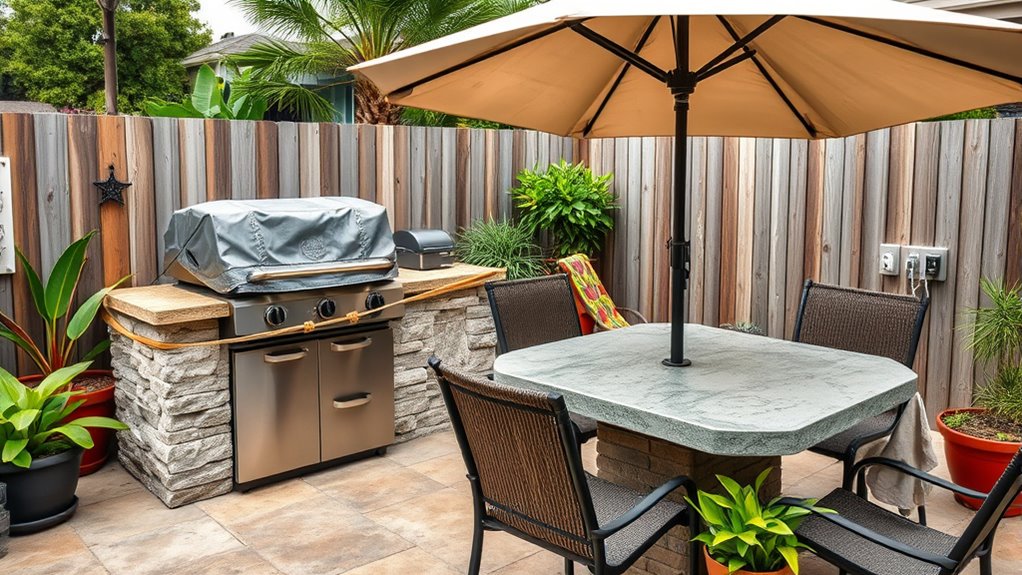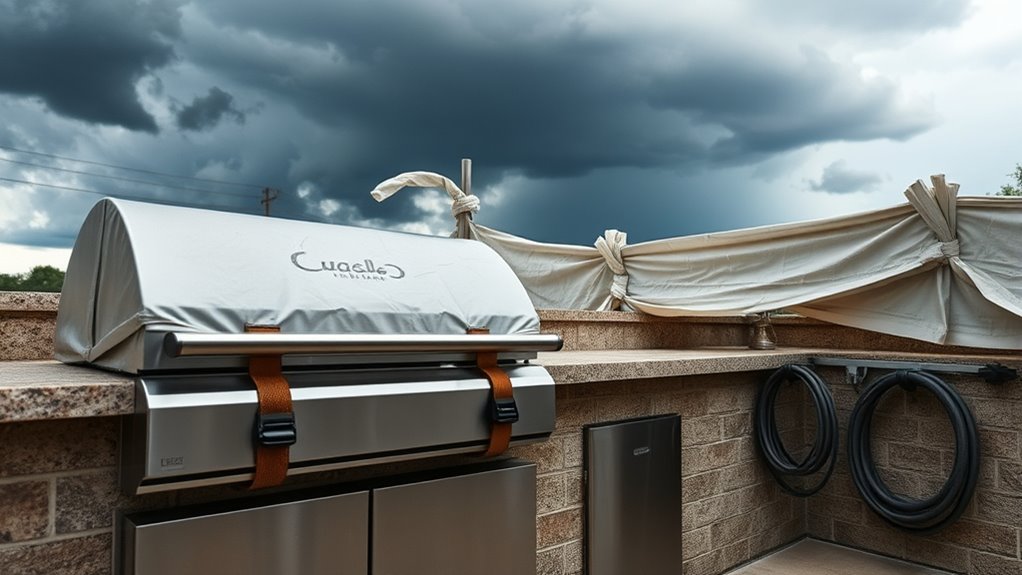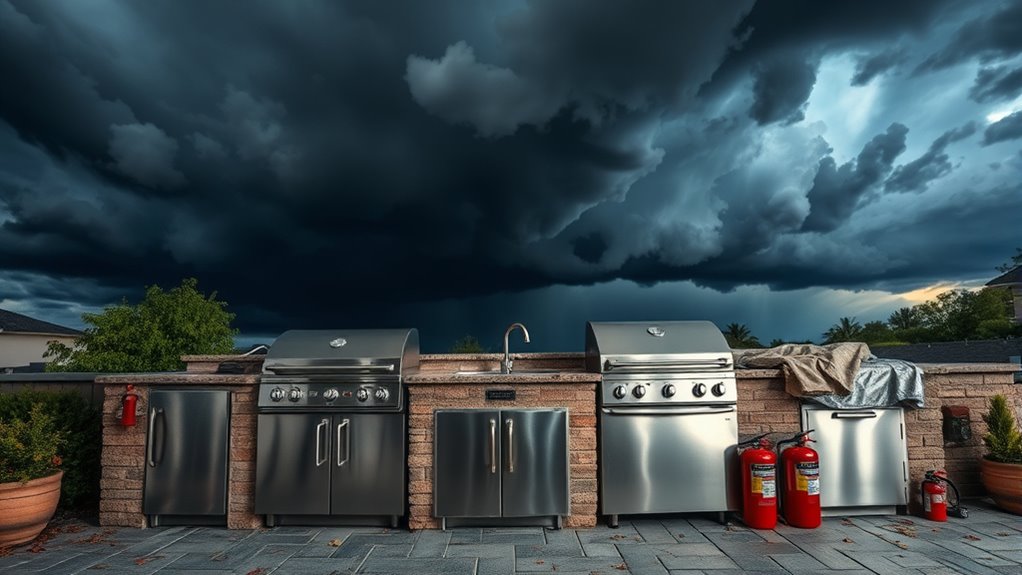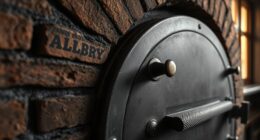To prep your outdoor kitchen for a storm, secure or anchor all furniture and lightweight décor to prevent tipping or flyaways. Protect utilities by waterproofing equipment, shutting off gas and electricity, and elevating sensitive appliances. Keep fire extinguishers and a first aid kit accessible, and make certain emergency contact plans are in place. Regularly inspect your setup and implement storm-resistant features. Continue exploring these essential safety steps to safeguard your space during severe weather.
Key Takeaways
- Secure or store outdoor appliances and furniture indoors or anchor them to prevent tipping or becoming projectiles.
- Install waterproof covers on equipment and ensure electrical connections are weatherproof and elevated.
- Regularly inspect and maintain outdoor lighting, wiring, and fixtures to prevent hazards during storms.
- Keep fire extinguishers, first aid kits, and emergency contact information accessible nearby.
- Develop and practice safety plans for weather emergencies, including evacuation routes and utility shutoff procedures.
Assessing and Securing Your Outdoor Space

Have you thoroughly evaluated your outdoor space to identify potential storm risks? Start by checking for lighting hazards, such as exposed wiring or unstable fixtures that could become dangerous projectiles. Secure or remove outdoor lighting that isn’t securely mounted. Next, examine your furniture stability. Flip or anchor heavy furniture to prevent it from tipping over or flying away during strong winds. Make sure tables, chairs, and storage units are sturdy and in good condition, avoiding loose or broken pieces. Clear your space of loose debris, such as umbrellas or lightweight décor, that could turn into projectiles. Regular maintenance and inspections can also help detect potential hazards before a storm hits. By assessing these hazards and securing your furniture, you reduce the risk of injury or damage when storms hit. Proper preparation keeps you and your outdoor kitchen safer.
Protecting Equipment and Utilities

Safeguarding your outdoor kitchen’s equipment and utilities is essential to prevent storm-related damage. Use fire-resistant materials for surfaces and coverings to reduce fire risk and protect electronics. Ensure all appliances, including grills and refrigerators, are securely anchored or stored indoors if possible. Installing utility shutoffs is a smart move—turn off gas, water, and electrical supplies before a storm to prevent leaks, fires, or electrical shorts. Clearly label shutoff valves for quick access during an emergency. Elevate sensitive equipment above potential flood levels or cover them with waterproof, fire-resistant covers. Regularly inspect and maintain these protective measures to keep everything in good shape. Implementing storm-resistant features can further enhance the safety of your outdoor kitchen during severe weather. Taking these precautions minimizes storm damage and keeps your outdoor kitchen safe and ready for use once the weather clears.
Emergency Preparedness and Safety Measures

Preparing your outdoor kitchen for emergencies starts with developing a clear plan and gathering essential safety equipment. You need to make certain fire extinguisher readiness by regularly checking and maintaining extinguishers nearby. Create an emergency contact plan that includes local fire, ambulance, and utility numbers, and share it with everyone. Keep a first aid kit accessible for minor injuries. Install smoke and carbon monoxide detectors in nearby areas, and familiarize yourself with their operation. Practice safety drills so everyone knows what to do if fire or severe weather strikes. These steps help minimize risks and ensure quick responses during crises, keeping everyone safe and your outdoor space secure. Additionally, being aware of safety equipment options can further enhance your preparedness. Prioritizing these safety measures makes storm preparedness more effective and manageable.
Frequently Asked Questions
How Often Should Outdoor Kitchen Equipment Be Inspected for Storm Readiness?
You should perform an inspection for storm readiness check at least once a year, preferably before storm season begins. Regular inspection frequency guarantees your outdoor kitchen equipment stays secure and functional during storms. Focus on tightening fittings, checking for corrosion, and securing all components. If storms are frequent in your area, consider more frequent inspections, such as quarterly, to promptly address any vulnerabilities and guarantee your outdoor kitchen is prepared for severe weather events.
What Specific Materials Are Best for Storm-Resistant Outdoor Kitchen Covers?
Your outdoor kitchen deserves armor against the fiercest storms, so choose weatherproof fabrics that can withstand hurricane-force winds and relentless rain. Reinforced frames made of heavy-duty steel or aluminum provide unbeatable strength, preventing damage from flying debris. These materials create a fortress that keeps your equipment safe and dry, ensuring your outdoor culinary haven remains intact and ready to serve, no matter how wild the weather gets.
Are There Local Regulations for Storm-Proofing Outdoor Kitchens?
Yes, you need to check local codes and zoning rules before storm-proofing your outdoor kitchen. These regulations vary by area and may specify requirements for storm-resistant materials, structure height, or setbacks. Contact your local building department or zoning office to verify your modifications comply. Ignoring these rules could lead to fines or safety issues, so always verify what’s permitted before making any storm-proofing upgrades.
How Can I Secure My Outdoor Furniture During a Storm?
You should secure your outdoor furniture by anchoring it to the ground or using heavy-duty weights to prevent movement during a storm. Cover your outdoor furniture with storm resistant covers to protect it from wind and rain. If possible, store smaller pieces indoors or in a shed. These steps will keep your outdoor furniture safe and minimize damage, ensuring your outdoor space stays in good shape after the storm passes.
What Are the Signs That My Outdoor Kitchen Needs Immediate Storm Protection?
You should act immediately if you notice weather warnings or signs of an approaching storm, such as darkening skies, strong winds, or heavy rain. These signs indicate your outdoor kitchen is vulnerable to storm damage. To prevent damage, secure or cover appliances, close cabinets, and remove loose items. Ignoring these warnings can lead to costly repairs and safety hazards. Stay vigilant and act quickly to protect your outdoor kitchen from storm damage.
Conclusion
By taking these storm prep steps, you’re not just protecting your outdoor kitchen—you’re shielding your entire backyard kingdom from chaos! Imagine a hurricane of debris, lightning strikes, or a deluge tearing through your space—without proper safety measures, disaster could strike in seconds. But with these simple precautions, you’ll be like a fortress, unstoppable and ready for anything Mother Nature throws your way. Stay prepared, stay safe, and keep your outdoor oasis intact no matter what!









